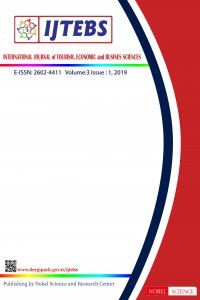OSMANLI DÖNEMİNE AİT KÜLTÜREL ZENGİNLİĞİN BOSNA-HERSEK CUMHURİYETİNDE TURİZM AÇISINDAN DEĞERLENDİRİLMESİ
OSMANLI DÖNEMİNE AİT KÜLTÜREL ZENGİNLİĞİN BOSNA-HERSEK CUMHURİYETİNDE TURİZM AÇISINDAN DEĞERLENDİRİLMESİ
XXI. since the beginning of the century, the World Tourism Organization’s statistical data reveal that 37% of the participants in tourism movements constitute cultural tourism and that this demand will increase by 15% every year. The statistical data reveal that the “cultural tourism” demand represents a significant market segment. Cultural tourism, an important type of alternative tourism for the countries, is a type of tourism that is emphasized in terms of “increase in the number of tourists” and “protection of cultural values” as well as “income effect”. Nations, who hope for tourism, have gone on to develop competitive and salable products and to form strategies in order to get more share from world tourism. The history and cultural heritage of nearly 500 years of Ottoman domination, which occupies an important place in the history of the Balkans, These nations that broke out of the Ottoman Empire in the Balkans a century ago and emerged as a nation state, The fate that has been reshaped between the East and West Blocks that emerged after World War II. In the last quarter of the century, the eastern bloc wrecked the Balkans into a restoration process. We will present an inventory of traces of Ottoman cultural heritage on the borders of the Republic of Bosnia and Herzegovina, one of the emerging states of the former Yugoslavia, which is scattered as part of this process, and we will evaluate this cultural richness in terms of tourism.
___
- Abdulbaki, Gölpınarlı, (1953), Mevlana’dan Sonra Mevlevilik, İstanbul 1953.
- Akoğlan Kozak, M., Bahçe, S. (2009), Özel İlgi Turizmi, Detay Yayıncılık, 1. Baskı, Ankara.
- Albayrak, Kadir. (2004). Bogomilizm ve Bosna Kilisesi. Adana: Baki Kitabevi.
- Baltacı, Cahit.(2005) XV.-XVI. Asırlarda Osmanlı Medreseleri I, M.Ü. İlahiyat Fakültesi Vakfı Yayınları, İstanbul.
- Bojić, Mehmedalija. (2001). Historija Bosne i Bošnjaka. Sarajevo: TKD Šahinpašić.
- Castellan, G. (1995). Balkanların Tarihi. II. Baskı, İstanbul: Milliyet Yayınları.
- Chloe, Tam (2001), Cultural Tourism : Singapore and Hong Kong, Unpublished Master’s Thesis, Hong Kong University.
- Djurdjev, Branislav.(1992). “Bosna Hersek”. İslam Ansiklopedisi. İstanbul: TDV.
- Evliya. Çelebi, (Hicri:1315). Seyahatname, İstanbul, cilt:V.
- Güngör, Yüksel (2010). Balkanlar’da Osmanlı Devri Eserleri, (Basılmamış) Ders Notları.
- Halaçoğlu, Yusuf. (2007) .XIV-XVII. Yüzyıllarda Osmanlı Devlet Teşkilatı ve Sosyal Yapı. Ankara :Türk Tarih Kurumu.
- Hodziç, İsmajil (2007). Bogomilizm ve Bosna-Hersek Bogomilleri, Ondokuzmayıs Üniversitesi Sosyal Bilimler Enstitüsü Felsefe ve Din Bilimleri Anabilim Dalı, Basılmamış Yüksek Lisans Tezi, Samsun.
- Honggang, Xu, (2003), “Managing Side Effects of Cultural Tourism Development-The Case of Zhouzhuang”, Systems Analysis Modelling Simulation, Vol. 43, No. 2, February, pp.175-188, Taylor&Francis.
- Hughes, H., ve Allen, D., (2005), “Cultural tourism in Central and Eastern Europe: the views of ‘induced image formation agents”, Tourism Management 26.
- Imamović, Mustafa. (1998). Historija Bošnjaka. Sarajevo: Preporod,
- İbrahimi, Mehmet.(1993) “Eski Yugoslavya’da İslam Kültürünün Yerleşmesinde Tarikatların Önemi”, İslami Araştırmalar, VI/4.
- Jalimam, Salih. (1999). Historija Bosanskih Bogomila. Tuzla: IPP Hamidović, s.17-20.
- Kolb, B. M. (2006).Tourism Marketing for Cities and Towns . Oxford: Elsevier Inc.
- Kresmarik, J. (1993). “Bosna-Hersek”. İslam Ansiklopedisi. İstanbul: MEB. cilt. II.
- Leslie, D., (2001), “Urban Regeneration and Glasgow’s Galleries with Particular Reference to the Burrell Collection”, Edited by RICHARDS, Greg, Cultural Attractions and European Tourism, CAB International, UK.
- MacDonald, R.; Jolliffe, L., (2003), “Cultural Rural Tourism: Evidence from Canada” Annals of Tourism Research, 30.2, 307-322.
- Malcolm, Noel (1999). Bosna’nın Kısa Tarihi, Türkçesi: Aşkım Karadağlı, Om Tarih Yayınları, İstanbul.
- Richards, G. (2001). Cultural Attractions And European Tourism, New York: Cabı Publishing.
- Škaljic, A. (1966). Turcizmi u Srpsko-Hrvatskom Jeziku. Sarajevo: Svjetlost.
- Turan, Ömer ve Mehmet Z. İbrahimgil.(2004). Balkanlardaki Türk Mimarî Eserlerinden Örnekler. Ankara: TBMM Kültür, Sanat ve Yayın Kurulu Yayınları.
- Turhan, Mümtaz (1994), Kültür Değişmeleri, İstanbul: İFAV Yayınları.
- Wang, S., Fu, Y.-Y., Cecil, A., Avgoustis, S. H. (2006). Residents’ Perceptions of Cultural Tourism And Quality of Life- A Longitudinal Approach, Tourism Today, Fall.
- Başlangıç: 2017
- Yayıncı: Nobel Bilim ve Araştırma Merkezi Limited
Sayıdaki Diğer Makaleler
PARANORMAL TURİZM BAĞLAMINDA TIRNAVA CADILARI
Sami KARACAN, Esin KARACAN, Yüksel GÜNGÖR
TEKNOLOJİ TRANSFERİNİN TOPLAM KALİTE YÖNETİMİNE ETKİSİ
Gülin İdil SÖNMEZTÜRK BOLATAN, Sıtkı GÖZLÜ
Adem YAVAŞ, Erkan TAŞKIRAN, Ömür ALYAKUT, Emrah ÖZKUL, Tülay ÜZÜMCÜ
YARGICI VE MUDO CITY MARKALARININ SANAL ORTAM TEMSİLLERİ ve INSTAGRAM ÖRNEĞİ
YENİLİKÇİ İNSAN KAYNAKLARI YÖNETİMİ UYGULAMALARININ YENİLİK ODAKLI BİR KÜLTÜR OLUŞTURMADAKİ ROLÜ
Ayşe GÜNSEL, Saadet Ela PELENK
YÜKSEK ÖKÇELER ÖYKÜSÜNÜN ELEŞTİREL SÖYLEM ANALİZİ İLE DEĞERLENDİRİLMESİ
